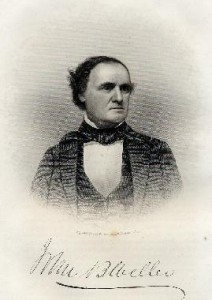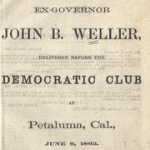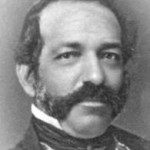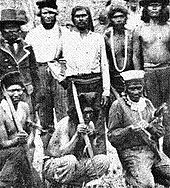Happy Belated Birthday Governor Weller!
John B. Weller, California’s 5th governor who used his clemency powers more than any two-year chief executive and whose pro-South leanings led him to sign legislation allowing Southern California to become the territory of Colorado was born 200 years ago on February 22.
He forcibly took control of San Quentin from the outside vendor hired to operate it and presided over the Mendocino War, authorizing a private 40-man army to quell attacks on settlers in Round Valley by the Yuki Indians.
The Democrat and Ohio native was one of California’s U.S. senators from 1852 until January 1857, replacing John C. Fremont.
 Weller was sworn in as governor on January 8, 1858. He used his inaugural speech to decry mob justice – like that he witnessed as a San Francisco lawyer in cases arising from the actions of the Vigilance Committee – tighten the state’s budgetary belt and higher investment in public education.
Weller was sworn in as governor on January 8, 1858. He used his inaugural speech to decry mob justice – like that he witnessed as a San Francisco lawyer in cases arising from the actions of the Vigilance Committee – tighten the state’s budgetary belt and higher investment in public education.
“That I can reconcile conflicting interests, heal divisions which exist amongst the people, and steer the ship of state clear of all the shoals and rocks which discordant elements have thrown in her track, I can scarcely expect.
“It will, however, be my constant aim to administer the affairs of the executive office in such manner as to advance the interests of the state and secure the confidence and respect of honest men.”
As to the court of public opinion, Weller said:
“It is far more important that I should be right than that I should be praised, and therefore I will do what I conceive to be my duty, at all times and under all circumstances, and leave the vindication of my character, if assailed, to my acts and to posterity.”
Two years later, as he left office, Weller offered this advice to his successors:
“He who expects to find the executive chair an easy one will be sadly mistaken. It is difficult, indeed, in a community like ours, where so many duties are imposed upon the governor, and where there are so many conflicting elements at work, to administer public affairs satisfactorily to the people.
“(The governor’s) efforts to promote the general good will not always be properly appreciated and his motives will sometimes be misunderstood or misrepresented.”
SOUTHERN CALIFORNIA SECESSION
Weller devoted the conclusion of his inaugural speech to the question of slavery, which would tear the country apart within two years.
“The people of California, with great unanimity, decided that slavery should not exist in this state. No one denies our right so to decide nor do any of our sister states attempt to interfere with this question,” Weller said.
“Other communities, in the exercise of their sovereignty, have seen proper to tolerate slavery. They have a right to enjoy their institutions without being disturbed by us.
“The agitation of the slavery question in the Northern states, while it has in no degree benefited the African race, has engendered a feeling which is now threatening the permanency of the government.”
That same agitation threatened to break California apart — and would have had not Congress refused to consider the issue in the wake of Abraham Lincoln’s 1860 election and the resulting secession crisis.
A split between Northern California anti-slavery Democrats and Southern California pro-slavery Democrats had been widening for several years prior to Weller’s 1857 election.
In 1853, pro-slavery Democrats, calling themselves the “Chivalry,” sought to break Southern California off into a separate territory that would allow slavery.
They led the Free Soil faction of anti-slavery Democrats, modeled after the federal anti-slavery party of the same name.
California’s U.S. Senator William Gwin headed the pro-slavery faction.
In his 1852 run for the Senate, Weller’s opponent was Broderick. Gwin and his supporters backed Weller.
While Weller was in Washington DC, the polarization between Northern and Southern California grew.
The 1853 Democratic convention unraveled over the issue of slavery, splitting into two conventions each nominating their own candidate.
Chivalry aligned with the opposing Whigs and Bigler eeked out a victory.
(According to one report, to win the Sacramento legislative delegation’s support, Bigler pledged to move the capitol there. He signed a bill doing so in 1854.)
While Weller was in the U.S. Senate, state lawmakers had already made two attempts to split California.
The third was the Pico Act, introduced by Assemblyman Andres Pico, a Californiowho previously served as acting governor of Alta California in 1847.
This time, lawmakers approved the plan. And Weller, with his Southern leanings, signed it. Voters in the new territory approved the move by over 70 percent.
But when sent to Washington for congressional ratification, other sectarian issues kept the legislation from ever coming to a vote.
WELLER’S PRE-CALIFORNIA DAYS
Part of Weller’s Southern temperament stemmed form his youth. He was born in Hamilton County, Ohio, in the southwest corner of the state, near the Kentucky border.
Weller was a student at the University of Miami in Oxford, in Butler County, also in the southwestern corner of Ohio.
The southern parts of Ohio had considerable commercial dealings with the south.
He never graduated from the university. As one account puts it: Weller had “more reputation for frolicsomeness than scholarship.”
Weller’s political life began as prosecuting attorney of Butler County.
He defeated his former tutor in the law to become a member of the House of Representatives in 1839 where he served until 1845.
Those six years, at a minimum, would have increased his interaction with Southern politicians and likely led to mutually beneficial political alliances.
Weller raised a company of volunteers during the Mexican War, which became part of the Second Ohio Regiment of Volunteers. He led is troops at the Battle of Monterey with bravery.
A failed bid for Ohio governor in 1848 led to a political appointment in January 1849 as a member of the International Boundary Commission, which was charged with setting the borer between Mexico and the United States.
He traveled to New Orleans, arriving there February 25 but did not reach San Diego, his destination, until June 1.
After his arrival rumors began to circulate he had run amok in New Orleans, bringing a hooker with him to the Isthmus before taking ship to San Diego. Whig papers leveled a variety of other charges against him, which led to President Zachary Taylor’s Whig administration recalling him.
Wrote Weller in an August letter from San Francisco:
“It is rumored I am suspended. As far as personal interests are concerned, I have no regret if the rumor is true. I can readily find professional employment here.”
After becoming involved in California politics, Weller was elected by the Legislature in 1852 to replace Fremont in the Senate.
The man he bested, David Broderick, beat Weller in 1857.
FROM RED TO BLACK INK
Weller initially grappled with many of the same issues his four predecessors did – particularly the condition of the state’s finances.
He called for “rigid economy,” complaining that every year since California statehood, state government expenditures “far exceeded” receipts.
“A state, as well as an individual, must be ultimately bankrupted, if its expenses are allowed, for a series of years, to exceed its income,” he said in his inaugural address.
One year later in his first address to the Legislature, Weller proudly announced that the state’s “finances are in a much more prosperous condition than at any other period since the organization of the state. The interest upon the public debt is being promptly paid and our bonds rank as high in the market as those of our sister states.”
In 1860 he noted that state coffers contained $311,654.18 more than when his administration began.
Nonetheless, he told lawmakers:
“The expenditure, in the legislative and judiciary departments, can be easily reduced without injury to the public service. It has been the practice heretofore to employ a much larger number of persons in the Legislature than are necessary to transact the public business.”
PRISONS & PARDONS
Weller also complained in his inaugural speech about the extravagant cost of incarcerating the state’s prison inmates – $120,000 per annum – when other states made prisoners self-supporting by using them as unpaid labor.
On March 1, just under two months after taking office, Weller, his lieutenant governor and the secretary of state physically wrested control of San Quentin from agents of John McCauley, the private vendor running it. Dissatisfied with his performance, lawmakers enacted a measure the month before authorizing Weller to “possess” the prison.
The three men did indeed take over the prison, breaking down several doors to gain possession of the keys. Said Weller to the Assembly afterwards a “little force” was required.
The lieutenant governor remained at the prison, acting as warden, until January of 1859 and placed the institution on “as respectable a footing as the crowded condition would allow,” Weller told lawmakers.
McCauley sued, however, and the state Supreme Court overturned Weller and the Legislature’s “takeover.”
Weller noted that during the state’s 13-month control of San Quentin, 21 inmates escaped. After McCauley was reinstated, 69 escaped in three months.
“To say nothing of those who had been killed by the guard,” Weller noted.
In his report on the “takeover,” Weller decried laws that sent men to prison for excessively long periods. First offenders convicted of grand larceny were receiving 10-year and 15-year sentences, Weller noted. Of particular criticism was the penchant of courts to send youthful offenders to San Quentin.
Prison is “the most efficient school of villainy that can be found in any country,” Weller told lawmakers.
In his 1860 message to the Legislature (See Page 36), Weller argued for an overhaul of the prison system including the opening of a second facility – either at Folsom or some other location.
“Great difficulty is experienced by discharged convicts in obtaining employment,” Weller said. “They are sent from the prison indifferently clad with means scarcely sufficient to reach San Francisco.
“Are we not, as Christians and as men, under obligations to do something toward encouraging this unfortunate class?”
During his two years as governor, Weller granted 77 pardons, six commutations and 60 restorations of citizenship rights, like voting.
“It is difficult, indeed, to refuse to exercise the power, when we have it, to send joy and gladness to the hearts of those laboring under the deepest afflictions; to restore to an affectionate wife an erring husband, whom she still loves, or to a fond mother her wayward and reckless, though not vicious, son,” Weller told lawmakers in 1860.
“If I have erred, it has been upon the side of mercy and I am satisfied.”
WAR IN MENDOCINO
It fell to Weller to prosecute one of the more obscure chapters in California history – the so-called Mendocino War.
Thousands of Pomo Indians in northeastern Mendocino County, including the aggressive Yuki tribe, were placed on a federal reservation in 1856 called the Nome Cult Farm in Round Valley, where the city of Covelo is located.
Provisions were inadequate and the Indians raided cattle of neighboring settlers. Finding a dead cow sparked a retributory strike against the Indians. Settlers complained the federal troops stationed there showed more interest in the welfare of the Indians and in 1858 petitioned Weller to take action.
In the summer of 1859, Weller authorized Walter S. Jarboe of Ukiah to raise a voluntary force.
The 20 men Jarboe recruited called themselves the Eel River Rangers and for the five months they were in existence took their job opf quelling alleged Indian violence seriously. Too seriously, according to some of the complaints lodged by the U.S. Army of the violence employed by Rangers Army.
A description of one Ranger raid by the Alta Californian:
“The attacking party rushed upon (the Indians), blowing out their brains and splitting their heads open with tomahawks. Little children in baskets — and even babes — had their heads smashed to pieces or cut open. Mothers and infants shared the same phenomenon.…Many of the fugitives were chased and shot as they ran. The children scarcely able to run, toddled towards the squaw for protection, crying with fright, but were overtaken, slaughtered like wild animals, and thrown into piles.…One woman got into a pond hole, where she hid herself under the grass, with her head above water, and concealed her papoose on the bank in a basket. She was discovered and her head blown to pieces, the muzzle of the gun being placed against her skull and the child was drowned in the pond.”
In response to charges he was waging a war of extinction, Jarboe said he was merely following Weller’s orders.
Jarboe estimated 283 warriors were killed and 292 captured. He kept no tally of the casualties to Indian women or children killed.
In January of 1860, Weller thanked Jarboe and the Rangers for “a job well done” and then disbanded the group. Jarboe and his men were paid $9,000 for their services.
A legislative investigation later that year absolved the Rangers of any wrongdoing.
In February 1859, Weller sent arms to Sheriff Clay Stockton of Shasta County to help thwart a potential anti-Chinese riot involving some 300 armed men.
“This spirit of mobocracy must be crushed out, no matter what blood it may cost,” Weller wrote the sheriff.
Ironically, Weller had signed a bill in 1858 to halt further immigration of Chinese to California.
OF PUBLIC SCHOOLS, LOBBYISTS, RAILROADS & ROTUNDAS
Weller noted in his last address to lawmakers that both the number of schools and the attendance at them had increased during his term.
In 1858, 22,244 children attended private or public schools. In 1859, 27,601. The number of school districts grew from 411 to 463. State spending on schools during the same period climbed almost $90,000 to $427,003.
Weller was no fan of lobbyists. He criticized them in the second paragraph of his 1859 address to lawmakers, saying: “Special legislation has hitherto done much to injure the State. Acts have sometimes found their way upon the the statute book, which are only intended to aggrandize individuals; and outside agents have frequently controlled legislation,” Weller said.
“(I) direct your attention to one of the evils which has existed in California, as well as elsewhere, since the foundation of the state government — I refer to the influence exercised over legislation by those who are usually called ‘Lobby Members.’
“Gentlemen of influence and position are frequently found at the Seat of Government, during the session of the Legislature, selling out their services to secure the passage of laws. Caring but little for the merits of the measure, they are ready, for a consideration, to undertake its passage.
“It need not be said that when legislation is transferred from the Chamber and Hall to the ” Lobby,” the public treasury will soon be plundered. When the Legislature is used for the purpose of passing bills concocted by speculators, public confidence must soon be destroyed, and the legislative power brought into contempt.”
As governor, Weller was also a strong advocate of a railroad linking California with the rest of the nation.
Without one, Weller said in his inaugural speech, “a war with any respectable maritime power would cut us off effectually from our sister states and leave out trade, our material wealth, if not our lives, at the mercy of the public enemy.”
As he left office, Weller called for construction of a Capitol in Sacramento.
“It is believed that $100,000 will put up a wing sufficiently commodious to accommodate the Legislature and state officers. And judging from the number of persons seeking employment at this time, labor can be obtained at rates but little more than it commands in the East,” Weller said in 1860, noting that the $8,000-a-year rent the state was currently paying constituted 8 percent of the estimated cost of the new building.
POSTSCRIPT
 Weller had four wives, three of whom died. He met his fourth, Elizabeth “Lizzie” Brockelbank Staunton, while in the Senate. They had two children and raised a third from one of Weller’s previous marriages.
Weller had four wives, three of whom died. He met his fourth, Elizabeth “Lizzie” Brockelbank Staunton, while in the Senate. They had two children and raised a third from one of Weller’s previous marriages.
History does not record any of her activities as First Lady.
The Democrats did not renominate Weller in 1859. He attempted a political comeback in 1863, as did former governor Bigler. Both failed to win a seat in Congress.
Weller became increasingly strident in his defense of the Confederacy, condemning Lincoln in a lengthy June 6, 1863 speech in Petaluma for trying to subjugate the South.
He left the state in 1864 and never returned, moving to New Orleans in 1867 where he practiced law. California’s fifth governor died there in 1875 of small pox.
-30-
Filed under: California History
Capitol Cliches Conversational Currency Great Moments in Capitol History News Budget and Economy California History Demographics Fundraising Governor Legislature/Legislation Politics State Agencies
Opinionation Overheard Today's Latin Lesson
Restaurant Raconteur Spotlight Trip to Tokyo Venting Warren Buffett Welcome Words That Aren't Heard in Committee Enough






Thanks for sharing your thoughts on api binance php.
Regards
Comment by teaching binance — 4.11.2022 @ 9:11 am